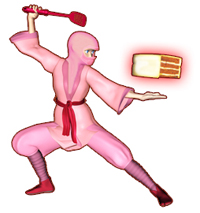Japanese Moon Gazing & Other Secrets to Enjoying Life in Stormy Weather
24/7 news tickers feed us with reasons to shiver and quiver with fear. Yes, it’s good to be aware and ready to take action. But how about taking a break from tensing the muscles from fight or flight impulses and learning to whoop and holler with joy? Even if it’s expressed quietly with “an inside voice.”
Many Japanese have mastered the art of joie de vivre by moon gazing. Much of the culture in Japan is influenced by the import of Chinese characters and literature, which includes an emphasis on the sun and moon. Over time, however, the Japanese have favored the moon.

Photo Credit: Click Here
Some suggest the Japanese sensibility lends itself to a deeper appreciation of the subtle changes of the waxing and waning moon. A treasuring of simplicity and understated refinement is found in the traditional art, calligraphy and food presentation of Japan. (A striking contrast to the more opulent artwork and piled-high dishes from China.) One Japanese friend speculates that the country’s lunar fascination is because “the moon is romantic and moody.”
1. Take Time Outs
From ancient times when harvesting rice was key to survival to today’s corporations sweating to make a profit, the Japanese have always found time to take a small time out for pleasure. From my many years of working for Japanese corporations, I believe the time outs (mini coffee breaks and chats accompanied by a slice of apple or small cookie) fueled my colleagues to dedicate themselves to more work and hours of overtime.
Centuries ago, master Haiku poet, Basho observed:
Husking rice?
a child squints up?
to view the moon.

Photo Credit: Click Here
2. Acceptance
Acceptances of the inevitable changes of the moon, of the season’s influences are also key to the serene demeanor demonstrated by many Japanese.
Through my husband David, I met lovely Carol, an American woman who married a Japanese man named Fumio. Although he passed away before I had a chance to meet him, I heard that all who were close to Fumio were consistently impressed by his serene acceptance of life's travails. In a troubling situation Fumio would usually say “Can’t be helped.” ????? (shikata ga nai)
I wasn't surprised to hear that because it's a phrase that many Japanese people use to express acceptance of a situation. It's a mindset which comes with a Japanese upbringing. One accepts a situation and moves on: Letting it go or taking appropriate action.

The Seven Lucky Gods of Japan:
Protectors of Abundance, Beauty, Strength, Riches, Music, Art - the Sweet Stuff of Life
Photo Credit: Click Here
3. Believe!
I have always admired the quiet confidence and optimism inherent in my Japanese colleagues, teachers and bosses. Perhaps it has something to do with belief in the phrase I picked up from a Japanese drama series about a girl who survived the Kobe earthquake of 1995. ???????(nan to ka nari masu) means we’ll manage somehow. Whenever I’ve repeated the saying to my Japanese friends, they laugh and seem to light up as they recognize the truth in the statement. There is a knowing that even if the moon is a mere sliver today, with time, a full circle will once again illuminate the skies. While we are living and breathing and taking action to make our circumstances better, there is always hope.
Mii Temple?
knocking on the gate for a wish?
today's moon
-Basho

Photo Credit: Click Here
4. Attitude
Of course, attitude is a major player in how we feel about this thing called life. How we choose to perceive the waxing and waning of love, fortunes and other riches is contingent upon our attitude.
Again, the ancient Haiku master, Basho says it best:
My storehouse burnt down. ?
Nothing now stands in the way?
of moon viewing. ?
Translation: Kit Nagamura
5. Savor the moments
The last of the great Ukiyo-e woodblock print artists of the 1800s was Tsukioka Yoshitoshi. His One Hundred Aspects of the Moon (Tsuki Hyakushi) celebrates everyday life in ancient Japan and pays homage to the lunar miracle in the sky.
Find at least one way to discover pleasure today.
Here are a few Ninja Baker goodies inspired by the moon.
Curry Crescent Moon
The ever popular Japanese version of curry is the perfect filling for ready-to-make crescent rolls (found in the refrigerator section of your supermarket.) The sauce is also readily available for purchase online or at your local Asian market. Bake the crescent rolls per package instructions and enjoy as a delightful appetizer or snack.
Apple Pie Half Moons
Super easy and perfect for the Ninja on the go.
- Using your one cup measuring cup to cut out circles from premade pie dough.
- Chop up half a package of assorted pre-sliced apples.
- Also, chop up a generous handful of walnuts.
- Add a generous handful of dried cranberries to the apples and walnuts.
- Coat the apples, dried cranberries and nuts with cinnamon sugar by shaking in a sealable plastic bag. Sprinkle in a dash of nutmeg.
- Place the mixture in a bowl and spread 2 to 3 tablespoons of melted butter over the concoction. Also, sprinkle a bit of Bisquick or flour over the mixture and combine well.
- Insert a half tablespoon of the mixture onto each cut out circle and seal the edges with a drop of water.
-
Bake at 425 degrees for about 15 minutes or until golden brown.
Full Moon Comfort Biscuits
Bake up your favorite biscuits and slather with strawberry jam or honey butter.
Fun fact: The Japanese are the biggest producers and consumers of dessert strawberries.
Wishing you profound joy whether the moon of good fortune is waxing or waning.
|
The Ninja Baker
© ™ Watkinson 2012 |
The Ninja Baker's recipes are also available at:
?Allrecipes.com: |
|

